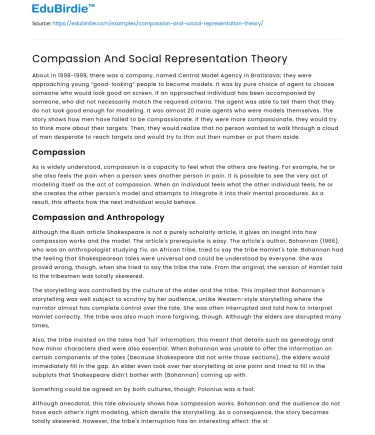Introduction
Compassion, a fundamental human emotion, plays a pivotal role in fostering social cohesion and promoting well-being across societies. Simultaneously, Social Representation Theory (SRT) provides a framework for understanding how shared beliefs and values shape collective consciousness. By examining compassion through the lens of SRT, one can unravel the complex interplay between individual emotions and societal constructs. This essay delves into the symbiotic relationship between compassion and social representation by exploring how they influence each other. While compassion often drives social representation by molding societal norms and values, the converse is equally true; social representation can shape how compassion is perceived and enacted within different cultural contexts. By integrating theoretical perspectives with real-world examples, this exploration aims to highlight the nuances of compassion as a socially constructed phenomenon. Furthermore, it addresses potential counter-arguments to reinforce the thesis that compassion and social representation are inextricably linked, thereby underscoring the importance of recognizing this interdependence in contemporary discourse.
The Interplay Between Compassion and Social Representation
Compassion, inherently an emotional response, is deeply embedded in the social fabric of communities. Social Representation Theory, proposed by Serge Moscovici, suggests that shared beliefs and social constructs significantly influence individual and collective behaviors. The theory posits that social representations are not merely passive reflections of societal values but active constructs that shape and are shaped by individual cognitions and emotions. In this context, compassion can be viewed as both a driver and a product of social representations. For instance, in societies where altruism and empathy are highly valued, compassion becomes a central tenet of social representation, guiding behaviors and interactions. This dynamic is evident in numerous cultural practices, such as the emphasis on community support in collectivist societies or the valorization of charity in religious contexts. As Moscovici (1984) highlights, "Social representations are the means by which individuals make sense of the world and their place within it." Hence, compassion, as a socially valued emotion, contributes to the formation and perpetuation of social representations, reinforcing societal norms and collective identities.
Transitioning from theoretical constructs to practical implications, it is essential to recognize how social representation shapes the expression and understanding of compassion across different cultures. In Western societies, compassion is often associated with individual philanthropy and charitable acts, reflecting a social representation that emphasizes personal responsibility. Conversely, in Eastern cultures, compassion may be viewed as an intrinsic part of communal living, where collective well-being takes precedence over individual achievements. This divergence highlights the role of social representation in shaping not only the expression of compassion but also its perceived significance within various cultural frameworks. The interplay between compassion and social representation thus underscores the importance of considering cultural contexts when analyzing emotional and social phenomena, as these contexts significantly influence how compassion is conceptualized and enacted.
Counter-Arguments and Reaffirmation of Thesis
While the relationship between compassion and social representation appears robust, it is not without contention. Critics may argue that compassion, as a fundamental human emotion, exists independently of social constructs and is primarily driven by biological and evolutionary imperatives. From this perspective, social representation merely provides a contextual backdrop rather than actively shaping the expression of compassion. However, this view overlooks the significant influence of cultural and social factors in modulating emotional responses. Research in cultural psychology suggests that emotions are not solely biologically driven but are also shaped by cultural norms and values. For example, Markus and Kitayama (1991) assert that "culture and self are mutually constitutive," indicating that cultural contexts significantly influence emotional experiences. Consequently, while biological predispositions may underlie compassion, social representation plays a crucial role in determining how this emotion is expressed and understood within different societies.
Furthermore, the argument that compassion exists independently of social constructs fails to account for the variability in its expression across different cultural and social settings. If compassion were purely a biological imperative, its manifestation would be uniform across diverse contexts. However, as evidenced by the varying societal attitudes towards compassion and the diverse ways it is enacted, social representation undeniably influences its expression. By recognizing the interplay between biological imperatives and social constructs, one can appreciate the complexity of compassion as both a universal human emotion and a socially constructed phenomenon. This perspective reaffirms the thesis that compassion and social representation are intricately linked, with each influencing and shaping the other in a continuous, dynamic interplay.
Conclusion
In conclusion, the exploration of compassion through the lens of Social Representation Theory reveals the intricate relationship between individual emotions and societal constructs. Compassion, while rooted in biological imperatives, is significantly influenced by social representations that shape its expression and understanding within different cultural contexts. By acknowledging this interplay, one can appreciate the complexity of compassion as both a universal emotion and a socially constructed phenomenon. Despite potential counter-arguments emphasizing the primacy of biological factors, the variability in the expression of compassion across cultures underscores the critical role of social representation. This essay underscores the importance of recognizing the interdependence between compassion and social representation, highlighting the need for a nuanced understanding of emotional and social phenomena in contemporary discourse. Ultimately, by integrating theoretical perspectives with real-world examples, this exploration affirms the thesis that compassion and social representation are inextricably linked, shaping and being shaped by each other in a continuous, dynamic interplay.






 Stuck on your essay?
Stuck on your essay?

